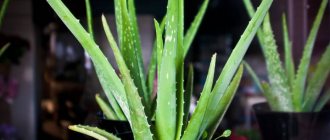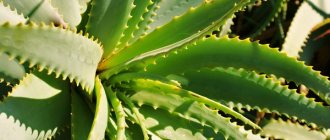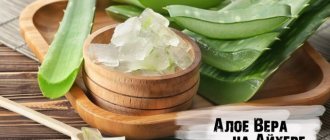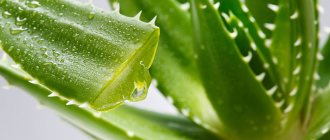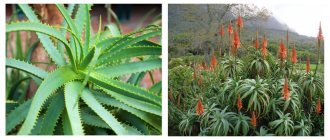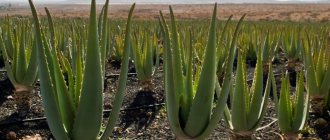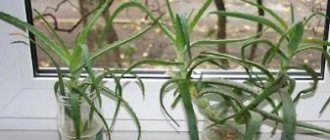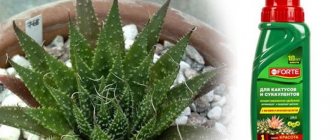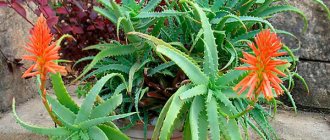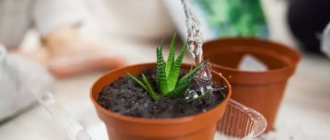For its healing properties and ease of care at home, tree aloe is one of the most popular indoor plants. The evergreen perennial tree-like aloe has another name among gardeners - agave. Many people mistakenly call all varieties of aloe agave. This is a misconception, since only aloe vera is called agave!
Briefly about care
- Watering. Water the plant sparingly, making sure that the top soil layer is sufficiently dry. In winter, the crop needs to be watered less frequently, about several times every 30 days.
- Illumination. A tropical crop needs a significant amount of sunlight, so the bush should be kept on the south side of the windows.
- Air humidity. The African succulent does not need spraying.
- Temperature conditions. The air temperature should not be higher than 25 °C in summer and lower than 13 °C in winter.
- Bloom. At home, the plant does not bloom.
- Trimming. If necessary, you can prune the perennial.
- Transfer. Young specimens need to be replanted every year.
- Priming. The soil mixture should be loose and consist of coarse sand, turf, leaf soil, and humus.
- Fertilizers. Tropical crops should be fed a couple of times a month from March to November.
- Reproduction. By cuttings and seed method.
- Diseases. Root and dry rot.
- Parasites. Mealybug, spider mite, scale insect.
Aloe or agave
What is the difference between agave and aloe vera? Both plants are succulents and belong to the Asphodelaceae family. However, agave is a subspecies of aloe and resembles a tree or bush with a distinct stem.
Look at the photo to understand the difference between agave and other types of aloe, as well as how to distinguish them.
The difference between tree aloe
What is the difference between aloe and aloe vera besides external signs?
Both plants contain useful and nutritious components, and therefore are actively used in medicine and cosmetology.
Agave and aloe vera have slightly different compositions and are used for different medicinal purposes. Flower growers still argue whether aloe vera or agave is more beneficial. Biologists and pharmacists are inclined to believe that both plants deserve to be on the list of medicinal herbs, since the juice and pulp of the plant are useful for many diseases.
When classifying a succulent, tree aloe is classified as a medicinal plant, not an ornamental one.
Contraindications for treatment with aloe vera
Despite the obvious benefits for cosmetic purposes (for hair and skin), for therapeutic and prophylactic purposes to increase immunity, improve the course of bronchopulmonary diseases and gastrointestinal diseases, the plant can bring not only benefits. Aloe leaves contain cell growth stimulants, which are indispensable for cell restoration and regeneration (rejuvenation and wound healing), so agave should not be used for oncology . Under the influence of these stimulants, all cells, including cancer cells, are activated. For cuts, agave is indispensable, but if the wound is purulent , then applying a fresh aloe leaf to it is not recommended, otherwise the top layer of skin will heal, but the pus will remain inside.
If there is no aloe on your windowsill yet, you should seriously think about placing a green healer on your windowsill. It is difficult to find a plant as versatile and valuable for our health!
Source
Description of the plant
The homeland of aloe vera (agave) is hot Africa. The plant got its name because it looks like a miniature tree.
Some people confuse tree aloe with fern or cactus. These are completely different plants.
Photos of tree aloe clearly prove that the perennial crop is similar to a tree. In nature, the crop can reach a height of several meters. In apartment conditions, the succulent grows up to one meter.
Medicinal properties
The medicinal properties of aloe vera were well known several millennia BC. The ancient Egyptians used the juice of this succulent to mummify their rulers. Today, a lot of clinical studies and drug trials using agave are being conducted. Most traditional medicine recipes have received scientific confirmation and justification.
Chemical composition
Agave leaves contain:
- resinous substances;
- ester composites;
- phytoncides;
- beta-carotene;
- vitamins C and E;
- phenols;
- organic acids.
pharmachologic effect
Medicines based on aloe vera and sabur (concentrated, condensed agave juice) have a laxative effect. Galenic preparations (tinctures, extracts) have a choleretic effect, reduce heartburn, increase appetite, and improve digestion.
Aloe juice prevents the proliferation of staphylococci, typhoid and dysentery bacilli. The medicinal properties of aloe agave are well known in folk medicine. Proof: recipes and detailed recommendations for use at home.
Transfer
A perennial should be replanted in certain cases: after purchasing a flower in a store, if the plant is cramped in an old pot, or if the flower is young, then it also needs to be replanted once a year.
To replant, you will need a new pot and soil suitable for the succulent. It doesn’t matter what material the pot is made of, it is important that it has a larger diameter than the previous one.
Transplanting aloe arborescens
During transplantation, an earthen lump is removed from the old pot along with the perennial, see the photo above. You can shake off excess soil and carefully examine the roots of the flower.
The roots must be healthy. Rotten or diseased roots should be carefully trimmed.
After a visual inspection, you should place the flower in a new pot, after pouring a drainage layer there. After placing the plant in a new pot, sprinkle it with soil, filling empty spaces and uneven areas.
There is no need to water the succulent after transplanting.
Recipes
The more pronounced the medicinal properties of a plant, the more side effects may appear.
Before starting treatment with agave, you should consult your doctor. The medicinal properties of aloe vera reach their peak after the plant is 3 years old. The collection of leaves begins from the bottom of the flower, cutting them off with a sharp knife near the stem. The cut is sprinkled with crushed activated carbon to reduce juice loss.
Before harvesting, the plant is not watered for 7–10 days. The cut leaves are wrapped in food foil or thick cloth and left for a week in a dark place at a temperature of 3 - 6 degrees Celsius.
Aloe leaves kept in the cold are passed through a meat grinder and used to prepare potions according to traditional medicine recipes. The shelf life of the processed plant should not exceed 1 month.
For the treatment of gastritis, colitis, constipation, gastroenteritis
The squeezed juice from the prepared plant is mixed with vodka or 40% alcohol in a proportional ratio of 1 to 1. In case of contraindications to drinking alcohol, alcohol is replaced with liquid natural honey. Take 1 teaspoon twice a day 20 minutes before meals. Is it possible to eat bananas if you have gastritis and stomach ulcers?
To activate the digestive system, improve appetite, increase the body’s internal resources
1 part of prepared aloe is poured with 4 parts of 40% alcohol. After a week, strain to remove dry residue. Take 1 teaspoon 2 times a day 20 minutes before meals.
For skin diseases
The prepared sheet is cut lengthwise and wiped over cleansed skin in the morning and evening. Does aloe vera help with acne and what are the most effective recipes?
For bleeding gums
Dry blackberry leaves are combined with dried St. John's wort flowers, prepared agave is added and boiling water is poured over. Strain and use to rinse the mouth after each meal. The proportional ratio of plant components is 2:2:2 per half liter of water.
Do bananas cause allergies, can they be used as a medicine for coughs, and what are the benefits of eating bananas with milk for children and adults?
Diseases
Improper care during cultivation can cause agave disease. One of the common diseases is root rot, which appears as a result of frequent and abundant watering.
Root rot in Aloe vera
At the first signs of disease, you should immediately reduce the amount of watering. It is also necessary to transplant the infected plant into another pot, inspecting and removing diseased roots.
To prevent the occurrence of root rot, use gravel, brick chips or charcoal.
In addition to root rot, the plant can develop dry rot. With this disease there are no external signs, because the flower dries from the inside.
Fungal disease in Aloe arborescens
Dry, yellowed leaves are a sign of “poor health” of the agave. Yellowed leaf blades may indicate a fungal disease. Leaves affected by the fungus should be carefully trimmed.
Planting/growing
Experienced gardeners recommend planting aloe in the spring, at the beginning of the growing season. This time is good for rapid rooting of a young plant. When planting aloe vera, it is very important to pay attention to the soil you will use. It must be loose, not retain water and have good air permeability. Chemical composition: slightly acidic or neutral. The composition should contain a lot of iron. Judging by the description, a mixture of leaf and turf soil, sand and humus is perfect. Compared to the other components of the mixture, there should be twice as much turf soil. To disinfect small stones, you can add charcoal to the soil. By the way, this component will also add a little looseness to the soil. Among the ready-made mixtures, you can buy soil for cacti or succulents. This is a nutritious substrate that will provide all the necessary elements for the active growth of a young plant.
Pests
Common pests that are dangerous to agave are spider mites, scale insects and mealybugs.
- When a crop is infected by a mealybug, the leaves become covered with an unpleasant whitish coating.
- Spider mites leave behind a substance similar to a cobweb.
- Leaves affected by scale insects feel sticky to the touch.
Scale insects on aloe vera
Pests suck out the sap of the plant, and if action is not taken in time, the succulent will wither and die.
A soap solution or insecticides will help get rid of parasites.
With proper care, the plant rarely gets sick. Carefully care for your indoor succulent, if you see an illness, immediately react and begin treatment, then the flower will thank you with its beautiful appearance and help in the treatment of many diseases.
Chemical composition
Chemical composition. Fresh leaves and juice of the plant contain enzymes, vitamins, and phytoncides. The following have been isolated from aloe leaves: aloin, nataloin, rabarberone, homonataloin, emodin, resinous substances and traces of essential oils.
The leaves contain: ash - 17.68%; macroelements (mg/g): K - 28.5, Ca -79.1, Md - 17.4, Fe - 0.32; microelements (CBN): Mn - 0.38, Cu - 1.10, Zn - 2.75, Co - 0.04, Cr - 0.08, A1
- - 0.09, Ba - 14.90, Se - 11.90, Ni - 0.45, Sr - 17.64, Pb - 0.22, I
- - 0.10, Li - 162.00. B - 94.00 mcg/g. Mo, Cd, V, Au, Br were not detected. Concentrates Ca, Mg, Cu, Zn, Se, Li, Ba, especially Ca, Zn, Se, Li. Can accumulate Mn, Cu.
Active ingredients
Fresh leaves and juice contain anthraglycosides - aloin, nataloin, rabarberone, emodin, resinous substances and traces of essential oils. They contain small amounts of enzymes, vitamins and phytoncides.
